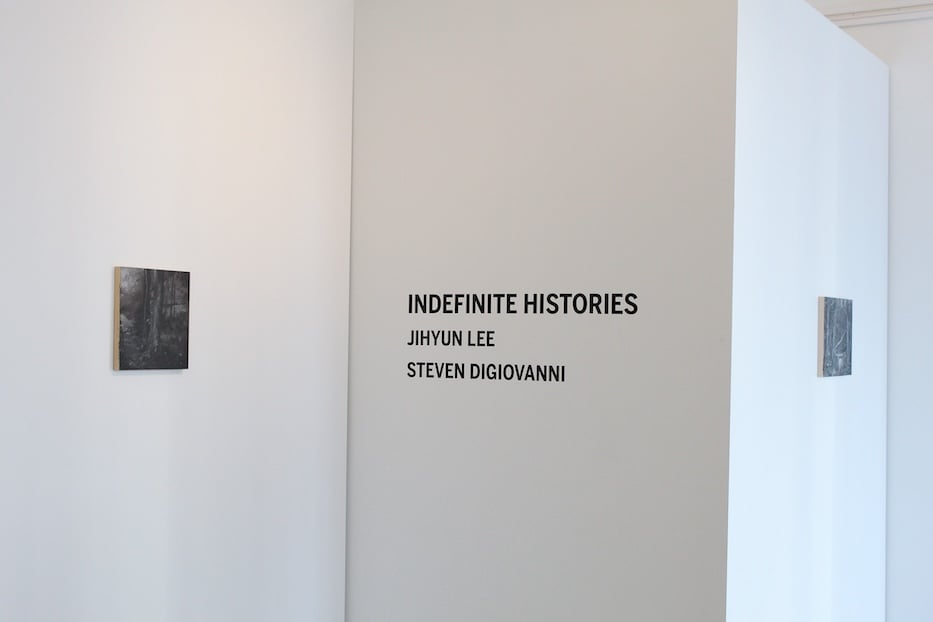
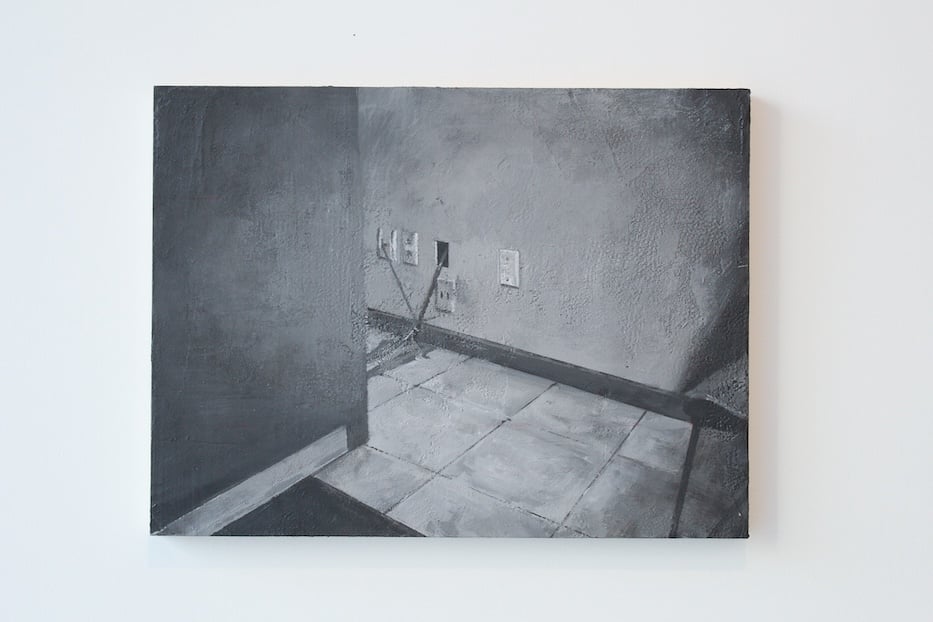
Work from artist Steven Digiovanni. Kapp Singer Photos; All work by the artists. Indefinite Histories runs November 6 to December 29 at Gateway Community College.
A cable snakes out of a stark rectangular hole in the wall; the plastic outlet cover is missing. Two other wires, these ones thinner, emerge from adjacent sockets, joining the first cable right above the wall’s molding. All three disappear underneath a thick piece of black tape stuck to a tiled floor.
The intensely mundane scene, rendered in monochrome on a 12 inch-square canvas, is one of several recent paintings by New Haven-based artist Steven Digiovanni on display in the new exhibition Indefinite Histories at Gateway Community College’s NewAlliance Foundation Art Gallery, located at 20 Church St. The show, curated by Noé Jimenez and also featuring work from local painter and sculptor Jihyun Lee, runs November 6 to December 29.
“The theme I identified in both of their work is memory,” Jimenez said. “I saw a mining from the past in order to create a new future, a new reality.”
Digiovanni’s new series, which he calls the Case File Paintings, are recreations of forensic photographs taken by his father, who worked as a safety investigator for personal injury attorneys when Digiovanni was a teenager. The compositions are simple and utilitarian.
In one, a steel railing winds down a set of stairs. In another, a puddle of water pools at the low point in a wooden floor. A third depicts a small residential street with a large tree halfway down the block; its trunk almost completely blocks the sidewalk and its roots spill out over the curb and onto the road.
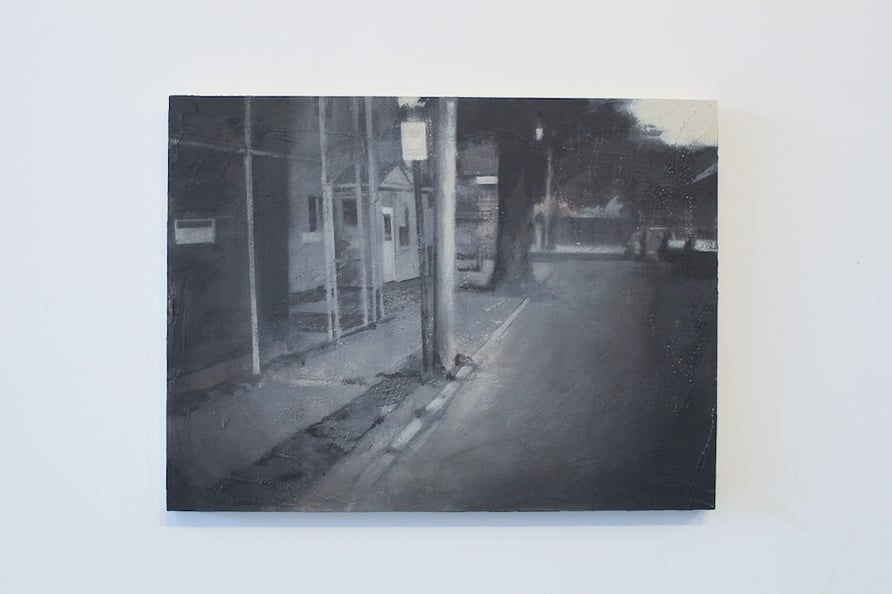
Despite the lack of human figures, these scenes contain traces of commotion and calamity—someone who tripped, slipped, or perhaps hit their head. When each of the original images were taken, a lawsuit was probably already in the works. To look at these paintings is to imagine what went wrong—to consider the precariousness latent in even the simplest of everyday infrastructures—and to wonder who might have been held responsible.
While the artist seeks to translate across media, from the camera to the canvas, Digiovanni’s painting style goes beyond a rote photorealism. In the Case File Paintings, he does not seem to want to invoke the exact likeness of his father’s photographs—he could have simply displayed these images themselves—nor flex technical prowess.
Rather, in the intricate texture of his brushstrokes and his careful choice of tones, Digiovanni simultaneously captures the flat, legal air of safety investigation photographs and a rich nostalgia for childhood. One gets the sense that the artist is using these images—vapid and eerie as they are—as a way to meditate on his past, on his relationship with his father.
Digiovanni’s modest compositions are counterposed against a series of large, colorful, overflowing works by Jihyun Lee. Lee’s standout piece in the show, a 60-by-120-inch diptych painting entitled Spinola Hours_March, April, sits squarely in the middle of the gallery, confronting the viewer head-on the moment they walk in.
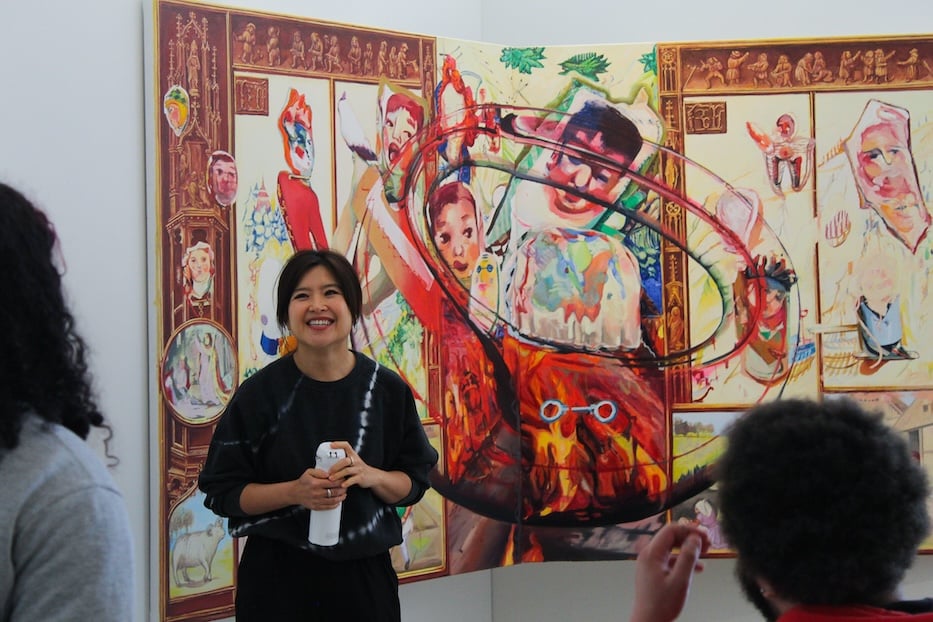
Jihyun Lee with her diptych Spinola Hours_March, April.
The painting is based on the Spinola Book of Hours, an illustrated Christian prayerbook made in 16th-century Belgium. Lee meticulously recreated numerous scenes from the book—images of farmers, shepherds, priests, animals, religious ornamental wood carvings—and transposed symbols from her own past within this collage of medieval life.
Characteristic of Lee’s work, Spinola Hours_March,April features several depictions of fabric dolls, which the artist’s mother would make for her when she was a child. They radiate out across the canvas, intersecting with and often obscuring the historic material from the prayerbook, and can be seen throughout Lee’s other pieces in the exhibition.
Lee began making this painting at the start of the Covid-19 pandemic as a way to reckon with the rapidly changing rhythms of daily life. In weaving together material from hundreds of years ago, from her childhood, and from the present, the chaotic and energetic work captures the historical contingency of routine—that each period of history, each period of our lives, proceeds in its own way. In contrasting stillness and motion, Spinola Hours_March,April communicates the feeling of living through inflection points in time.
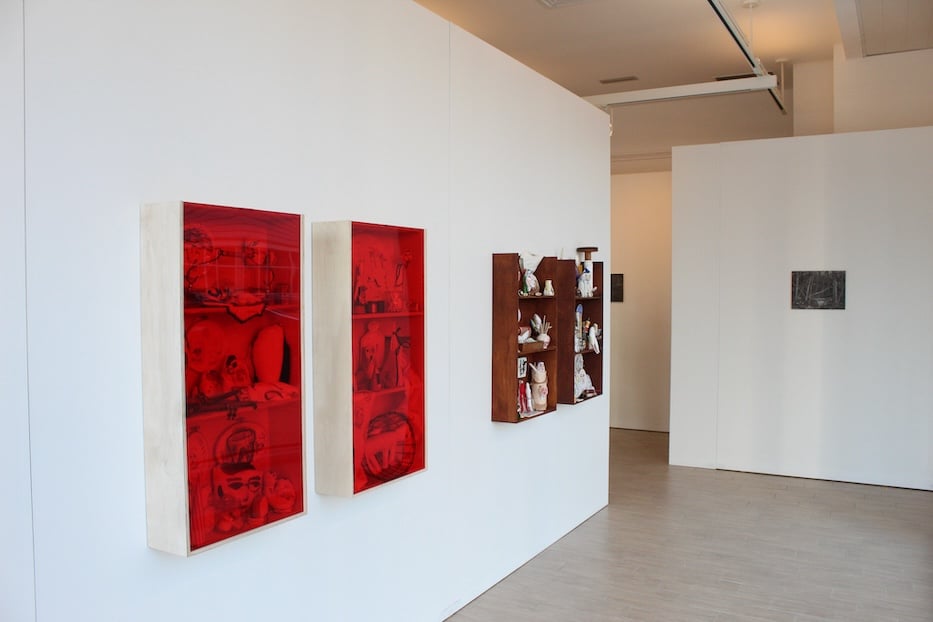
Lee's sculptures in the show.
“This is all about finding a balance between uncertainty and your ultimate goal,” Lee said at an artist talk at the gallery on Thursday morning. “If I can find the answer easily, I’m not gonna paint the painting.”
A large, transparent torus, canted slightly to the right, sits in the center of the scene. This donut shape, Lee explained, is meant to be a large zero, symbolizing the normal, neutral aspects of a daily routine—“nothing more nothing less,” she explained. It is imposing but ephemeral, at once appearing to be a wish for things to return to the way they were and an admission that things are always changing.
“Painting is all about the progression of remembering and forgetting,” Lee said. “And how our memories merge with each other’s.”